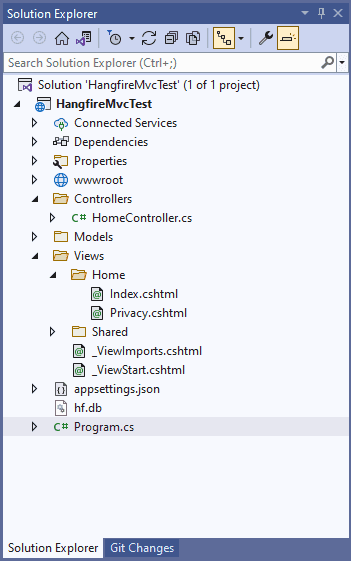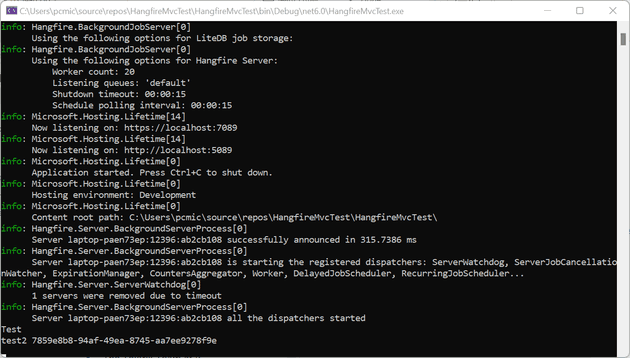One of the things that I’ve been looking into recently is Hangfire. I’ve used this in the past, but not for a while, and so I wanted to get familiar with it again. I imagine there’ll be a couple more posts on the way, but in this one, I’m going to detail how to get Hangfire running using .Net 6, and a Lite DB Storage. I did initially intend to create this with a SQLite DB; however, when I did, I found that the Hangfire messages were sending multiple times; after some searching, I came across this GitHub issue, which suggested the Hangfire.Lite storage.
In this particular article, we’ll look specifically at running Hangfire with an Asp.Net MVC project. In .Net 6, the default template looks like this:
The first step here is that you’ll need some additional refences; here’s the csproj:
<Project Sdk="Microsoft.NET.Sdk.Web">
<PropertyGroup>
<TargetFramework>net6.0</TargetFramework>
<Nullable>enable</Nullable>
<ImplicitUsings>enable</ImplicitUsings>
</PropertyGroup>
<ItemGroup>
<PackageReference Include="Hangfire.AspNetCore" Version="1.7.27" />
<PackageReference Include="Hangfire.Core" Version="1.7.27" />
<PackageReference Include="Hangfire.LiteDB" Version="0.4.1" />
</ItemGroup>
</Project>
In addition to the Hangfire Core and AspNetCore projects, there’s the LiteDB package.
The next step is, in program.cs:
using Hangfire;
using Hangfire.LiteDB;
var builder = WebApplication.CreateBuilder(args);
// Add services to the container.
builder.Services.AddControllersWithViews();
// HF
builder.Services.AddHangfire(configuration =>
{
configuration.UseLiteDbStorage("./hf.db");
});
builder.Services.AddHangfireServer();
// HF - End
var app = builder.Build();
// Configure the HTTP request pipeline.
if (!app.Environment.IsDevelopment())
{
app.UseExceptionHandler("/Home/Error");
// The default HSTS value is 30 days. You may want to change this for production scenarios, see https://aka.ms/aspnetcore-hsts.
app.UseHsts();
}
. . .
That’s actually it - that’s all you need to add Hangfire! However, it won’t, technically speaking, do anything. To test, edit the HomeCrontroller.cs:
public IActionResult Index()
{
var id = BackgroundJob.Enqueue(() => DoSomething());
return View();
}
public void DoSomething()
{
Console.WriteLine("Test");
Console.WriteLine($"test2 {Guid.NewGuid()}");
}
When you run the project, you should see Hangfire fire up and start printing outputs:
When you run it, don’t be too impatient - but it should print the test output.
References
https://github.com/HangfireIO/Hangfire/issues/1025
https://docs.microsoft.com/en-us/aspnet/core/fundamentals/routing?view=aspnetcore-6.0
https://docs.hangfire.io/en/latest/getting-started/index.html

